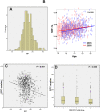SDF1 gene variation is associated with circulating SDF1alpha level and endothelial progenitor cell number: the Bruneck Study
- PMID: 19115008
- PMCID: PMC2605263
- DOI: 10.1371/journal.pone.0004061
SDF1 gene variation is associated with circulating SDF1alpha level and endothelial progenitor cell number: the Bruneck Study
Abstract
Background: Stromal cell-derived factor-1 (SDF1) and its receptor CXC chemokine receptor 4 (CXCR4) play a critical role in progenitor cell homing, mobilization and differentiation. It would be interesting to assess the predictive value of SDF-1alpha level for EPC number, and to ascertain whether there is a relationship between SDF1 gene variation, plasma SDF-1alpha level, and the number and function of circulating EPCs. We also tested whether EPC number and function was related to CXCR4 gene variation.
Methodology and principal findings: We genotyped a cohort of individuals who participated in the Bruneck Study for single nucleotide polymorphisms (SNPs) in the SDF1 and CXCR4 genes, and measured blood SDF1alpha level as well as EPC number and function. SDF1alpha levels were correlated with age, gender, alcohol consumption, circulating reticulocyte numbers, and concentrations of matrix metalloproteinase-9, C-reactive protein, cystatin C, fibrinogen and homocytein. In blood samples taken in 2005, EPC number was inversely associated with SDF1alpha level (p<0.001). EPC number in 2005 was also inversely associated with SDF1alpha level in 2000 (p = 0.009), suggesting a predictive value of plasma SDF1alpha level for EPC number. There was an association between the SDF1 gene rs2297630 SNP A/A genotype, increased SDF1alpha level (p = 0.002) and lower EPC number (p = 0.006).
Conclusions: Our data indicate that a SDF1 gene variation (rs2297630) has an influence on SDF1alpha level and circulating EPC number, and that plasma SDF1alpha level is a predictor of EPC number.
Conflict of interest statement
Figures


Similar articles
-
Functional SDF1 alpha/CXCR4 signaling in the developing spinal cord.J Neurochem. 2005 Apr;93(2):452-62. doi: 10.1111/j.1471-4159.2005.03049.x. J Neurochem. 2005. PMID: 15816868
-
Endothelial progenitor cells, cardiovascular risk factors, cytokine levels and atherosclerosis--results from a large population-based study.PLoS One. 2007 Oct 10;2(10):e975. doi: 10.1371/journal.pone.0000975. PLoS One. 2007. PMID: 17925881 Free PMC article.
-
Red wine consumption improves in vitro migration of endothelial progenitor cells in young, healthy individuals.Am J Clin Nutr. 2010 Jul;92(1):161-9. doi: 10.3945/ajcn.2009.28408. Epub 2010 Apr 14. Am J Clin Nutr. 2010. PMID: 20392892
-
Hypoxia inducible factor-1 alpha, endothelial progenitor cells, monocytes, cardiovascular risk, wound healing, cobalt and hydralazine: a unifying hypothesis.Curr Drug Targets. 2008 May;9(5):422-35. doi: 10.2174/138945008784221215. Curr Drug Targets. 2008. PMID: 18473772 Review.
-
Genetically manipulated progenitor/stem cells restore function to the infarcted heart via the SDF-1α/CXCR4 signaling pathway.Prog Mol Biol Transl Sci. 2012;111:265-84. doi: 10.1016/B978-0-12-398459-3.00012-5. Prog Mol Biol Transl Sci. 2012. PMID: 22917235 Review.
Cited by
-
Effects of tumour necrosis factor-alpha on activity and nitric oxide synthase of endothelial progenitor cells from peripheral blood.Cell Prolif. 2011 Aug;44(4):352-9. doi: 10.1111/j.1365-2184.2011.00764.x. Cell Prolif. 2011. PMID: 21702858 Free PMC article.
-
Association of Plasma SDF-1 with Bone Mineral Density, Body Composition, and Hip Fractures in Older Adults: The Cardiovascular Health Study.Calcif Tissue Int. 2017 Jun;100(6):599-608. doi: 10.1007/s00223-017-0245-8. Epub 2017 Feb 28. Calcif Tissue Int. 2017. PMID: 28246930 Free PMC article.
-
Fast reduction of peripheral blood endothelial progenitor cells in healthy humans exposed to acute systemic hypoxia.J Physiol. 2012 Feb 1;590(3):519-32. doi: 10.1113/jphysiol.2011.223032. Epub 2011 Dec 12. J Physiol. 2012. PMID: 22155931 Free PMC article. Clinical Trial.
-
Genetic variant in CXCL12 gene raises susceptibility to HPV infection and squamous intraepithelial lesions development: a case-control study.J Biomed Sci. 2018 Sep 18;25(1):69. doi: 10.1186/s12929-018-0472-y. J Biomed Sci. 2018. PMID: 30227860 Free PMC article.
-
Exosome-shuttled miR-126 mediates ethanol-induced disruption of neural crest cell-placode cell interaction by targeting SDF1.Toxicol Sci. 2023 Sep 28;195(2):184-201. doi: 10.1093/toxsci/kfad068. Toxicol Sci. 2023. PMID: 37490477 Free PMC article.
References
-
- Asahara T, Murohara T, Sullivan A, Silver M, van der Zee R, et al. Isolation of putative progenitor endothelial cells for angiogenesis. Science. 1997;275:964–967. - PubMed
-
- Takahashi T, Kalka C, Masuda H, Chen D, Silver M, et al. Ischemia- and cytokine-induced mobilization of bone marrow-derived endothelial progenitor cells for neovascularization. Nat Med. 1999;5:434–438. - PubMed
-
- Kawamoto A, Gwon HC, Iwaguro H, Yamaguchi JI, Uchida S, et al. Therapeutic potential of ex vivo expanded endothelial progenitor cells for myocardial ischemia. Circulation. 2001;103:634–637. - PubMed
-
- Britten MB, Abolmaali ND, Assmus B, Lehmann R, Honold J, et al. Infarct remodeling after intracoronary progenitor cell treatment in patients with acute myocardial infarction (TOPCARE-AMI): mechanistic insights from serial contrast-enhanced magnetic resonance imaging. Circulation. 2003;108:2212–2218. - PubMed
Publication types
MeSH terms
Substances
Grants and funding
LinkOut - more resources
Full Text Sources
Medical
Research Materials

